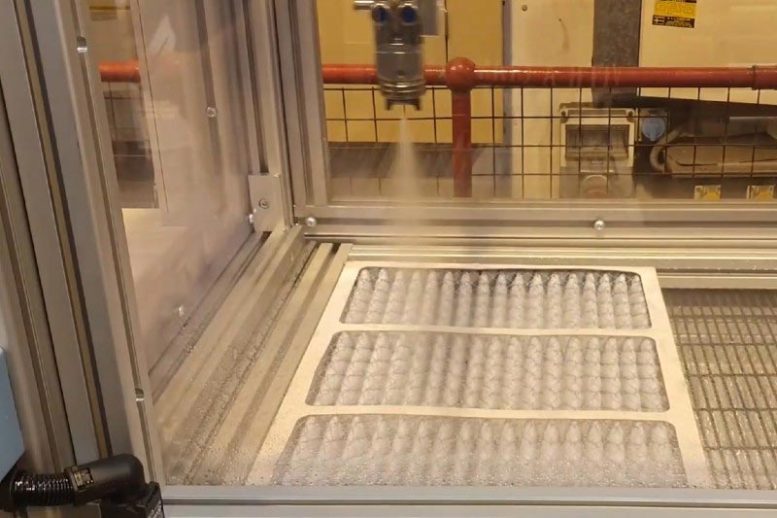
Crédit : Université de Birmingham
Les chercheurs de l’Université de Birmingham sont des chercheurs de la University of Birmingham working in partnership with firms NitroPep Ltd and Pullman AC have developed new antimicrobial technology for air filters which can in seconds kill bacteria, fungi, and viruses including SARS-CoV-2 — providing a potential solution to prevent the spread of airborne infections.
In a study, published on March 9, 2022, in the journal Scientific Reports, the antimicrobial treatment for air filters — coated with a chemical biocide called chlorhexidine digluconate (CHDG) — were rigorously tested and compared to commonly used standard ‘control’ filters in the laboratory, in industrial air condensing units, and in a trial on-board trains operating on the UK’s railways.
In the laboratory, cells of the Wuhan strain of SARS-CoV-2 – the virus that causes COVID-19 — were added to the surface of both the treated and control filters and measured at intervals over a period of more than an hour. The results showed that, while much of the virus remained on the surface of the control filter for an hour, all SARS-CoV-2 cells were killed within 60 seconds on the treated filter. Similar results were seen in experiments testing bacteria and fungi that commonly cause illness in humans – including E. coli, S. aureus, and C. albicans – proving the novel technology to be both highly effective anti-fungal and anti-bacterial air filter treatments.
Meanwhile, in order to determine how effective the filters are in a real-world setting, both the control and treated filters were installed in heating, ventilation and air conditioning systems on train carriages. The filters were installed for three months in matched pairs across carriages on the same train-line, before being removed and shipped for analysis with researchers counting colonies of bacteria remaining on them. The trial found no pathogens survived on the treated filter, even after three months on-board the train.
Further tests also found the treated filters are durable, and are able to maintain their structure and filtration function over the lifetime of their use.
Dr. Felicity de Cogan, Royal Academy of Engineering Industry Fellow at the University of Birmingham, said: “The COVID-19 pandemic has brought to the forefront of public consciousness the real need for new ways to control the spread of airborne respiratory pathogens. In crowded spaces, from offices to large indoor venues, shopping malls, and on public transport, there is an incredibly high potential for transmission of COVID-19 and other viruses such as flu. Most ventilation systems recycle air through the system, and the filters currently being used in these systems are not normally designed to prevent the spread of pathogens, only to block air particles. This means filters can actually act as a potential reservoir for harmful pathogens. We are excited that we have been able to develop a filter treatment which can kill bacteria, fungi and viruses – including SARS-CoV-2 — in seconds. This addresses a global unmet need and could help clean the air in enclosed spaces, helping to prevent the spread of respiratory disease.”
Dr. de Cogan said that, while there have been other novel filters to ‘purify air’ – from high-efficiency particulate air filters used in aerospace cabins, to UV light, and silver nanoparticles added to filter mesh — these have fallen short as they either lack energy efficiency or speed in effectiveness and are not ideal for the majority of existing heating, ventilation and air conditioning systems which would require significant infrastructure upgrades to use them.
Dr. de Cogan adds: “In comparison, the technology we have developed can be applied to existing filters and can be used in existing heating, ventilation and air conditioning systems with no need for the cost or hassle of any modifications. This level of compatibility with existing systems removes many of the barriers encountered when new technologies are brought onto the market.”
NitroPep Ltd is now further developing the filters to deliver them as a product on the market. The new technology is the latest stage of Dr de Cogan’s ongoing research creating patented antimicrobial technologies, which has included the development of a coating for surfaces called NitroPep that is also effective against SARS-CoV-2.
The latest study comes after previous research carried out globally has found that the risk of developing COVID-19 increases with greater public transport use,[1] tandis que d’autres études antérieures ont montré des taux plus élevés de maladies de type grippal chez les personnes voyageant dans le métro de Londres,[2] ainsi qu’une multiplication par 6 des infections respiratoires chez les personnes utilisant un tramway ou un bus.[3]
Référence : “Efficacité des filtres à air à revêtement antimicrobien et antiviral pour prévenir la propagation des pathogènes aéroportés” par Rowan Watson, Morwenna Oldfield, Jack A. Bryant, Lily Riordan, Harriet J. Hill, Julie A. Watts, Morgan R. Alexander, Michael J. Cox, Zania Stamataki, David J. Scurr et Felicity de Cogan, 9 mars 2022, Rapports scientifiques.
DOI: 10.1038/s41598-022-06579-9
Notes
- Shen ; Li ; Dong et al (2020). ‘Enquête communautaire sur la transmission du SRAS-CoV-2 parmi les usagers du bus dans l’est de la Chine.‘ JAMA Médecine Interne
- Gosce et al (2018). ‘Analyse du lien entre l’utilisation des transports publics et la transmission par voie aérienne : mobilité et contagion dans le métro de Londres.‘. Santé environnementale.
- Van Tam et al (2011). ‘Les transports publics sont-ils un facteur de risque d’infection respiratoire aiguë ?‘. BMC Infectious Diseases.
La nouvelle recherche, publiée dans Rapports scientifiquesa été financée par le Wellcome Trust, le Medical Research Council, le Engineering and Physical Sciences Research Council, la Medical Research Foundation, et Engineering X Pandemic Preparedness, géré par la Royal Academy of Engineering. Elle a été réalisée en collaboration avec NitroPep Ltd, Pullman AC Ltd, et l’Université de Nottingham.


